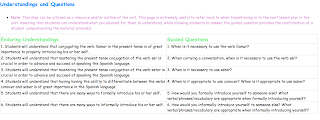The next step in the five step process of completing this unit, is the section titled "Critical Content and Skills." This section is used to specifically define what students will know from each lesson, what they will be able to do after this lesson plan, and what they will be required to create as their summative assessment. The product for the summative assessment can be anything from a test to an iMovie. Basically the summative assessment is the student's opportunity to make their understanding of the content evident to the teacher. Assessing students can be extremely fun using different online sources that students will enjoy creating!
For the first lesson plan, I decided to make the summative assessment simple because of this being their first time exemplifying their knowledge of the Spanish language. This product will end up being a resource for the students as well as a way for me to know that they are "getting" the material. Because llamar will most likely be the first verb in the Spanish language that students have ever been introduced to, the assessment that they will be required to complete is going to be a memorization tool for them to refer back to when learning other verbs. I would like them to make some sort of poster, visual, book of flash cards that they can use to master the -AR verb present tense conjugations.
For the second lesson plan, they will be introduced to the verb "ser." For their summative assessment students will work together to create a Glogster that will provide a visual of their understanding of the verb ser. If you have never heard of a Glogster, it's basically an online poster board. You can use images from online and organize them in whatever fashion you'd like. Students will work in pairs to create a visual that will be presented in class. What they will have to explain to the class is why they used specific images on their Glogster. For example, students may put a picture of a student, because you would use ser to say "Yo soy estudiante," something permanent. They would then explain to the class that they put a picture of a student on their Gloster because of that reason. Similar to this lesson plan, for the third lesson plan, students will create another Glogster, but they will use it to show their understanding of the verb "estar," because it is often confused with "ser" because they both translate in English as "to be."
For the fourth lesson, students will be focusing on differentiating between the two "to know" verbs conocer and saber. To distinguish the two, the students will first create a rough copy of a Venn-Diagram to show the similarities and differences between the two verbs. Their final project for this lesson will be creating a Venn-Diagram that is more visually appealing using the application Inspiration. Similar to the first lesson plan in this unit, this final Venn-Diagram can be used as a tool that they can keep and reuse to make sure they are using the two verbs properly.
For the last two lessons students will be creating an iMovie and a Comic Life to create stories that exemplify their understanding of how to formally and informally introduce themselves using all of the verbs and vocabulary that they have learned in the first four lessons.




